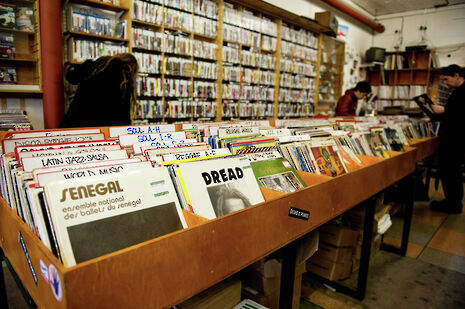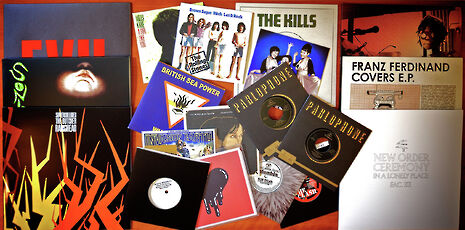For the Love of Vinyl
Joanne Stewart waxes lyrical about music’s guilty pleasure…
The year is 2004. Shaun of the Dead takes the UK by storm, and I can’t help but laugh as a desperate Simon Pegg lobs vinyl records at zombies. A few weeks later, I see a Young Enterprise group selling kitsch bowls made from 12” and 7” discs melted down and moulded into whimsical knick-knacks. Things weren’t looking too good for vinyl back then. From being threatened by a sexier, slimmer and shinier audio storage competitor, to being depricated as the ideal missile to fight a zombie apocalypse, the future was bleak for the humble record. And let’s not speak of the whippersnappers set on boiling LPs down in the attempt to make a quick buck and add a few credits to their CV.

But oh, how the (turn)tables have turned! It’s 2013, and figures released last week by the British Phonographic Industry reveal that vinyl record sales are at a 10 year high. I can see my 2004 self, frosty pink iPod Mini in hand, rolling her eyes in disbelief that I too am now a contributor to the statistic that 18 to 24 year olds are buying more vinyl than any other age group under 50.
Eager music fan I may be, but trained audiophile I am not. With an aural ability that is less Lassie and more gammy-eared mutt, I would probably struggle to differentiate a vinyl pressing from a FLAC, AAC or 256 bit MP3 on a blind listen. My iTunes library contents together play longer than man can survive without water. And yet this abundance of digital music spanning genres, decades and countries wasn’t enough to stop me from wanting to experience the vinyl record revival. Unlike well-behaved digital files, squeezed into itty-bitty bytes, I’ve found that owning vinyl is akin to having a gremlin. Records need to be carefully supervised, stored out of direct sunlight and kept bone dry. Expose the rascals to any of the above and they’ll become warped, bulbous troublemakers, spitting and hissing at any chance they get.
However, I cherish every crackle and hiss of these records, my ear tuning in to every play, discovering a new quirk or distortion each time. The very act of playing a vinyl is problematic, however, in that playing them is precicely what damages them. But, as anyone who enjoys live music will know, it is often the technical hiccup that reanimates the track you have listened to countless times. Ageing vinyl offers the listener a new perspective on what we now assume to be a fixed experience. Vinyl aficionados extol the sonic warmth of the medium, but be warned: this very warmth will probably end up burning a hole in your pocket. From looking after turntables to buying discs, investing in vinyl isn’t for those lacking in heart or dollar.

And yet, for the vinyl aficionado, the thrill is in the physical experience. She embarks on intrepid adventures in her quest to perfect her collection. She risks asbestos poisoning as she roots around her uncle’s attic in search of the Bowie LP vaguely mentioned in conversation two years ago. Rising at the crack of dawn, she treks to car boot sales in far-flung parishes in the hope of uncovering herHoly Grail: a pristine pressing of Pink Floyd’s The Dark Side of the Moon, perhaps. She will find herself on her knees in musty charity shops, calling on the spirit of Dr Barnardo to take pity on her by miraculously revealing a 12” of Prince’s Purple Rain behind the moth-eaten cardigans.
Graham Jones, author of hit book Last Shop Standing, suggests that vinyl “has saved many record shops and it is the reason that since 2009 more independent record shops have opened in the UK than closed.” Resident in Brighton, Rough Trade East in Brick Lane and the record stalls in Cambridge’s own Market Square all offer original or remastered LPs, rare 7” singles along with more current indie offerings from the likes of Vampire Weekend, The Black Keys and Arcade Fire. The aesthetic appeal of records shouldn’t be dismissed as vacuous shelf props, either. Take Sgt. Pepper’s Lonely Hearts Club Band. A tiny iPod screen cannot do justice to the trippy LSD magic of that cover. Look at the 12” case – a true miniature cardboard canvas – and ask yourself which famous face would you want to be stood beside in the lineup? Which hat would you don from the eclectic collection of boaters to stripy bonnets?
That record was revolutionary at the time not only for production values, but also for being the first to print lyrics on the back of the cover sleeve. Reading those lysergic etchings while being blinded by the dayglo riot of the cover art proves Sgt. Pepper’s to be a psychedelic masterpiece. For such a grandiose album, replete with lyrical and visual nuances, it comes as no surprise that the tangible product is so completely in tune with the music.
A personal favourite is the 1969 Let it Bleed by The Rolling Stones. The cover is a surreal pictorial concoction of a vinyl being played by an antique phonograph, whilst the record changer supports several items, including a tyre, pizza and a gaudy iced cake by the beloved Delia Smith. Imagining the idea of a modern day equivalent – perhaps a Hummingbird red velvet cupcake smooshed onto an iPod Nano – just doesn’t cut it for me.
While I profess my newfound appreciation for vinyl, I can’t say that I will be completely surrendering my white USB cable to analogue any time soon. Whether it’s played through an iPod or spun on a turntable, my primary concern is that the music is good.
 Comment / Plastic pubs: the problem with Cambridge alehouses 5 January 2026
Comment / Plastic pubs: the problem with Cambridge alehouses 5 January 2026 News / Cambridge academics stand out in King’s 2026 Honours List2 January 2026
News / Cambridge academics stand out in King’s 2026 Honours List2 January 2026 News / Cambridge businesses concerned infrastructure delays will hurt growth5 January 2026
News / Cambridge businesses concerned infrastructure delays will hurt growth5 January 2026 News / AstraZeneca sues for £32 million over faulty construction at Cambridge Campus31 December 2025
News / AstraZeneca sues for £32 million over faulty construction at Cambridge Campus31 December 2025 Interviews / You don’t need to peak at Cambridge, says Robin Harding31 December 2025
Interviews / You don’t need to peak at Cambridge, says Robin Harding31 December 2025








